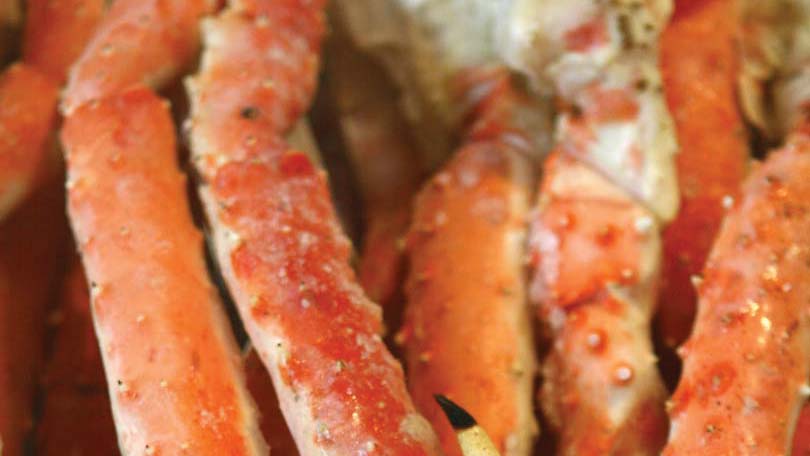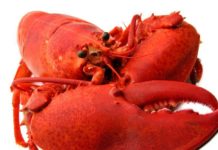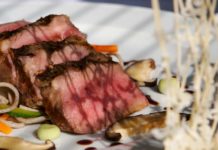
If you’ve ever tasted sweet king crab, you’ve probably already developed a love for this succulent shell fish. However, if you’re new to the world of crab, get ready for one of the tastiest treats in the ocean.
You’ve probably seen king crab in your grocer’s seafood section, but perhaps you’ve been intimidated by its large size and unusual shape. Maybe you’ve looked at it and tried to discern how best to prepare and serve it.
No fears! It’s really not very difficult to include king crab in your meals, and once you’ve tried it, you’ll go back again and again for more bites of this wonderful shellfish.
About the King Crab
As you may have garnered from its name, the king crab is the largest of the crab species and the most sought after for those earning their living as fishermen. Adult king crabs can reach a length of up to 8 feet. But regardless of length, king crab demands a hefty price.
This crab, also known as the stone crab, is found in the very cold seas, namely around Alaska, Russia, and also the Scandinavian countries, where they were introduced to the water by the Russians. (As a matter of fact, Norway is currently experiencing an alarming overpopulation of crab in the Barents Sea. The crab is destroying other marine life.)
Most experts agree that fishing for king crab is one of the most dangerous jobs in North America. That’s another reason why crab is so expensive. Those who fish for crab endure harsh weather and less than pleasant working conditions. But they keep coming back for more and are a proud lot of men whose fathers and grandfathers before them were crab fishermen and who will no doubt train their sons to love the sea as well.
Types of King Crab
In the waters of the vast Bering Sea and other nearby cold bodies of water, fishermen catch three kinds of king crab, each found in distinctly different parts of the sea. All three varieties are a little different though the taste is similar.
Red King Crab The mighty red king crab is dubbed the most prized species of crab in the world. Found in the waters of Alaska’s Bristol Bay and Norton Sound, the red variety of king crab is by far the best tasting of the three types. This type of king crab boasts beautiful white meat tinged with shades of red and is best served steaming hot. The exterior of the crab is dark red when caught and turns bright after cooking. Red king crab harvest varies from year to year, with some years offering a long harvest and others lasting only a few days. Regardless of the length of harvest, figures show that nearly 2 billion pounds of red king crab have been taken from Bristol Bay and Norton Sound since Alaska became a state in 1959, with a net worth of about $1.6 billion. Only sockeye salmon has been dubbed more valuable.
Blue King Crab Most of the blue crab consumed in North America is caught in the waters near St. Matthew Island and the Pribilof Islands, between Russia and Alaska near the Bering Strait. This species is best known for their gargantuan claws, often making this the largest of the three varieties of king crab. The taste is a close second to the red variety and diners are always astounded at the size of this species’ legs and claws. When the blue king crab is alive, it’s actually brown in color but tinged with blue highlights. When it’s cooked, it turns an orange-red color. That’s why many stores market it as red king crab, and it can taste nearly as good if it’s prepared correctly.
Golden (or Brown) King Crab These much smaller crabs are caught in the waters surrounding Alaska’s Aleutian Islands in deeper water than the other varieties. Because the golden crabs are smaller, they produce much less meat but are more affordable than the red or blue variety. Its taste is very similar, perhaps even a bit sweeter than its larger brothers.
Purchasing King Crab
When you view king crab at the fish counter, you may find the prices confusing. Basically, king crab is marketed according to how many legs it would take to make a 10 pound package. For example, really large legs might be labeled ‘6-9’, which indicates that it takes somewhere between 6 and 9 legs to add up to 10 pounds. Small golden crab legs may come in bundles of up to 24 pieces.
If the crab legs are not labeled ‘red, blue, or golden’, there are a few ways you can tell what you’re getting. Red king crab legs tend to be solid red and are thin and long. On the other hand, blue crab legs will be more of a reddish-orange color and the shape of the legs though also long and slender – tend to be more tubular than those of the red variety. Golden king crab legs are easy to discern because they will be much smaller and less expensive than the other two varieties.
Remember, crab legs are purchased after they’ve been cooked, so you won’t find the original shell color that fishermen see when they pull them out of the sea.
Cooking King Crab
King crab is cooked after it’s caught and is then flash frozen to ensure that its good taste will prevail by the time it reaches your table. Your job will be to reheat it so that it’s ready for consumption. You can do this in a number of ways.
First, thaw your crab in the refrigerator (not on the kitchen counter). If you need to thaw quickly, run it under cold water, bending the legs at the joints to see if you’ve accomplished your goal.
When it’s time to reheat, you can choose from several different methods including boiling, steaming, and baking, which are the most common. Reheating is a quick process, taking no more than about 7-8 minutes for very large king crab legs. Smaller ones can be reheated in as little as 4 minutes. Don’t overcook your crab as it’s likely to dry out and you’ll lose that wonderful, succulent texture.
Serving Crab Legs
King crab legs of any variety are usually served intact in their own natural shell. Everyone has their own favorite way of getting the meat out of the legs. Some use a standard nutcracker while others prefer a fork or knife. Some even use small hammers to penetrate the sometimes hard-to-break shell.
If you are hosting a party, you may want to pre-break the shells so as to make the whole process of eating the crab legs easier and less messy for your guests. Some seafood markets will split the crab for you if you request them to do so.
Remember to serve your steaming hot crab with a bowl of hot melted butter for dipping. Some chefs add a little something extra to the butter, like garlic, but that will depend upon individual tastes.





